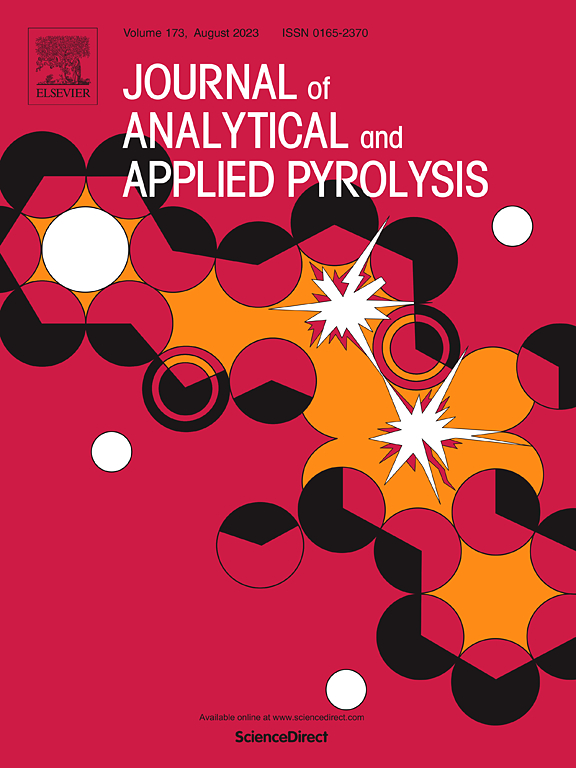生物质和聚对苯二甲酸乙二酯(PET)共同热解产生的生物油衍生化学品的利用前景
IF 5.8
2区 化学
Q1 CHEMISTRY, ANALYTICAL
引用次数: 0
摘要
全球对塑料的关注是一个非常重要的问题。通过热解对生物质和聚对苯二甲酸乙二酯(PET)进行共处理,可以作为重新利用这些材料的一种策略,将其转化为具有工业价值的产品。因此,本研究旨在了解生物质和 PET 共同热解对生物油(BO)的影响。使用的 PET 量分别为桉树生物质干基的 0%、15% 和 25%。共热解是在一个固定床反应器中进行的,反应器在低氧环境下进行,没有气体进入,最终温度为 450°C,有三种加热速率(1、3 和 5°C.min-1)。液体馏分经过两次蒸馏,产生纯化生物油(BOP),产率分别为 54%、57% 和 55%,仅受 1、3 和 5°C min-1 升温速率的影响。提纯后,对 BOP 的 pH 值、密度和粘度进行了分析。对 BOP 的化学成分进行了 GC-MS 分析。PET 的添加和加热速率的变化影响了所产生的 BOP 的成分。随着 PET 在生物质中所占比例的增加,液体密度降低。加热速率的增加使 BOP 的 pH 值从 2.75 降至 2.61。因此,较低的加热速率和 PET 比例往往会增加 BOP 的粘度。酮类是所有评估材料中最具代表性的有机化合物,其次是苯酚、呋喃和吡喃。本文章由计算机程序翻译,如有差异,请以英文原文为准。
Prospects for the utilization of bio-oil-derived chemicals generated via co-pyrolysis of biomass and polyethylene terephthalate (PET)
The global concern about plastic is a matter of great importance. Coprocessing biomass and polyethylene terephthalate (PET) through pyrolysis can represent a strategy to reuse these materials, transforming them into products of industrial interest. Thus, this study aims to understand the influence of the co-pyrolysis of biomass and PET on bio-oil (BO). The PET quantities used were 0 %, 15 %, and 25 % of the eucalyptus biomass dry basis. The co-pyrolysis was performed in a fixed-bed reactor in a low-oxygen atmosphere without gas entry at a final temperature of 450°C and three heating rates (1, 3, and 5°C.min−1). The liquid fraction underwent double distillation, producing purified bio-oil (BOP) with yields of 54 %, 57 %, and 55 %, respectively, influenced solely by the heating rates of 1, 3, and 5°C min−1. After purification, BOP's pH, density, and viscosity were analyzed. The chemical composition of BOP was subject to GC-MS analysis. The addition of PET and the variation in heating rate influenced the composition of the BOP produced. The liquid density decreased as the PET proportion in the biomass increased. The heating rate increase reduced BOP's pH from 2.75 to 2.61. Therefore, lower heating rates and PET proportions tend to increase the viscosity of BOP. Ketones were the most representative organic compounds in all evaluated materials, followed by phenols, furans, and pyrans.
求助全文
通过发布文献求助,成功后即可免费获取论文全文。
去求助
来源期刊
CiteScore
9.10
自引率
11.70%
发文量
340
审稿时长
44 days
期刊介绍:
The Journal of Analytical and Applied Pyrolysis (JAAP) is devoted to the publication of papers dealing with innovative applications of pyrolysis processes, the characterization of products related to pyrolysis reactions, and investigations of reaction mechanism. To be considered by JAAP, a manuscript should present significant progress in these topics. The novelty must be satisfactorily argued in the cover letter. A manuscript with a cover letter to the editor not addressing the novelty is likely to be rejected without review.

 求助内容:
求助内容: 应助结果提醒方式:
应助结果提醒方式:


